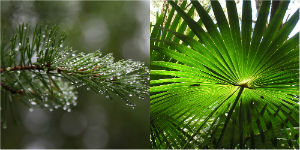Global team of researchers crack leaf size mystery
31 August 2017

Why is a banana leaf a million times bigger than a common heather leaf? Why are leaves generally much larger in tropical jungles than in temperate forests and deserts? The textbooks say it’s a balance between water availability and overheating.
But it’s not that simple.
Research published today as a cover story in the journal Science, led by Associate Professor Ian Wright from Macquarie University in Australia, reveals that in much of the world the key limiting factor for leaf size is night temperature and the risk of frost damage to leaves.
Ian, and 16 colleagues from Australia, the UK, Canada, Argentina, the USA, Estonia, Spain, and China analysed leaves from over 7,600 species, then teamed the data with new theory to create a series of equations that can predict the maximum viable leaf size anywhere in the world based on the risk of daytime overheating and night-time freezing.
The researchers will use these findings to create more accurate vegetation models. This will be used by governments to predict how vegetation will change locally and globally under climate change, and to plan for adaptation.
"We were able to show that simple ‘rules’ seemingly operate across the world’s plant species, rules that were not apparent from previous, more limited analyses" - Associate Professor Ian Wright, University of Macquarie
The iconic paintings of Henri Rousseau illustrate that when we think of steamy tropics we expect large leaves. But for scientists it’s been a century-old conundrum: why does leaf size vary with latitude – from very small near the poles to massive leaves in the tropics?
Associate Professor Wright said: “The conventional explanation was that water availability and overheating were the two major limits to leaf size. But the data didn’t fit. For example the tropics are both wet and hot, and leaves in cooler parts of the world are unlikely to overheat.
“Our team worked both ends of the problem – observation and theory. We used big data – measurements made on tens of thousands of leaves. By sampling across all continents, climate zones and plant types we were able to show that simple ‘rules’ seemingly operate across the world’s plant species, rules that were not apparent from previous, more limited analyses.
“Then, using our knowledge of plant function and biophysics we developed a fresh take on ‘leaf energy balance’ theory, and compared our predictions to observed leaf sizes."
Enriching 'next-generation' vegetation models
Professor Colin Prentice from Imperial College London, who co-ordinated the mathmatical modelling effort, said: “The most surprising result was that over much of the world the maximum size of leaves is set not by the risk of overheating, but rather by the risk of damaging frost at night.
"Larger leaves have thicker, insulating “boundary layers” of still air that slows their ability to draw heat from their surroundings – heat that is needed to compensate for longwave energy lost to the night-time sky."
Ning Dong, postdoctoral research assistant in Geography and Environmental Science at the University of Reading, who helped develop the mathmatcical model concept and led on model analysis, said: "Linking the modelling together with the empirical work let us create something very special, and this research has potential to enrich ‘next-generation’ vegetation models."
Photo credit: (L) Tiny connifer needles (credit Peter Reich) compared with (R) a large palm leaf (credit Michelle Leishman)
